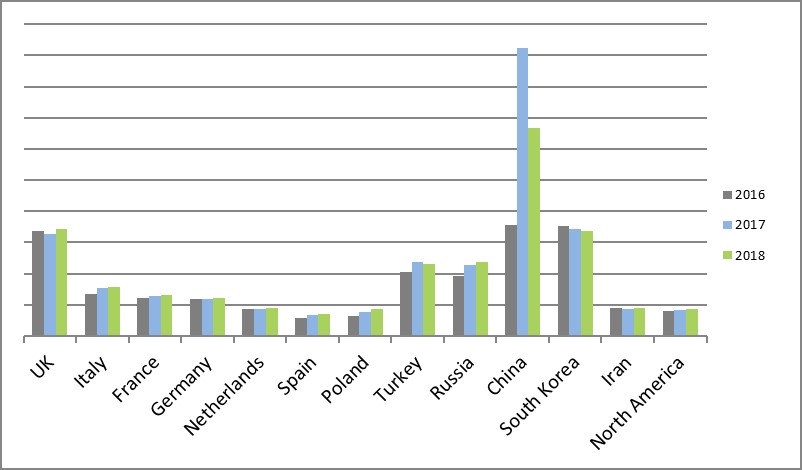Drivers of change in global heating markets

|
| World domestic boiler-sales dynamics, 2016 - 2018. BSRIA investigation of the countries’ market shares reveals a dynamic change of the competitive landscape as big players keep moving into emerging or faster growing markets. |
The Asia and Pacific region remains the largest heating market in the world, in volume terms, despite a decline in sales volume in 2018 by 8%. Wall-hung, non-condensing boilers dominate but heat pumps are increasingly important, reaching 40% of the heating market in that region. China, by far the largest heating market in the region, has seen mixed performance in 2018 with domestic boilers recording a significant fall in sales.
In Europe, ErP legislation has ensured that condensing boilers dominate the marketplace; Turkey has just introduced similar legislation making condensing technology mandatory. The trend away from floor-standing boilers towards wall-hung type continues and we saw a 6% swing in 2018, that is happening in both Western and Eastern Europe alike.
Europe has also recorded the dynamic growth of 13% in the hydronic heat-pump market, with France being a strong market leader in terms of the number of units sold and Germany, Ireland, Italy, Netherlands and UK being the most important markets in terms of growth recorded.Heating in North America continues to be dominated by furnaces, however wall-hung condensing boilers continue to make strong inroads to the residential market where they now account for 36%. Condensing technology is also progressing strongly with condensing residential and commercial boilers reaching the 57% share of the total boiler market.
The recently published BSRIA World Market Intelligence studies on heating monitor the global and regional heating markets and their dynamics in technology, sales volume and competitive environment. The reports explain heating practices of the countries, look at the impact of policies and technology innovations that aim to reduce CO2 emissions and respond to consumer expectations.
BSRIA reports include information on sales, with a high level of granularity in segmentation, on legislation, regulations and incentives, technology shifts, changes in energy prices and analysis of how all these factors affect each country’s market. Following its proven methodology, BSRIA also provides five years' forecast for market sales.
Globally, nearly all the biggest world markets have seen positive developments in both domestic boilers and heat pump sales. While heat pumps are mainly installed in new buildings, boilers are mostly sold for replacement. While legislation plays an important role for both type of products, energy efficiency, comfort and connectivity (that enables smartness) are becoming increasingly potent influencers too.
[edit] Key information
Global geographical coverage
Data in the reports supplied for 2017 and 2018, with forecasts to 2023.
Products coverage includes domestic and commercial applications
Based on primary and secondary research, face-to-face and telephone interviews
For more information on the availability and costs of BSRIA’s reports, contact the WMI sale department:
EMEA sales enquiries contact: BSRIA UK: bsria.co.uk wmi@bsria.co.uk or +44 (0) 1344 465 540
America sales enquiries contact: BSRIA USA: bsria.com sales@bsria.com or +1 312 753 6800
China sales enquiries contact: BSRIA China: [mailto:bsria@bsria.com.cn bsria@bsria.com.cn] or +86 10 6465 7707
[edit] About this article
This article was written by Socrates Christidis, Research Manager – Heating & Renewables - BSRIA’s World Market Intelligence Division. It was previously published in July 2019 on the BSRIA website and can be accessed here.
Other articles by BSRIA on Designing Buildings Wiki can be accessed here.
[edit] Related articles on Designing Buildings Wiki
- BSRIA global heat pump market 2019.
- Building services engineer.
- Combustion plant.
- Cooling.
- Corrosion in heating and cooling systems.
- Fan coil unit.
- Global challenges and opportunities in heating markets in 2020.
- Heat meter.
- Heat metering.
- Heat pump.
- Heat recovery.
- Heat stress.
- Heat transfer.
- Heating large spaces.
- Hot water.
- HVAC.
- Low carbon heating and cooling.
- Radiant heating.
- Radiator.
- Thermal comfort.
--BSRIA
Featured articles and news
A change to adoptive architecture
Effects of global weather warming on architectural detailing, material choice and human interaction.
How big is the problem and what can we do to mitigate the effects?
Overheating guidance and tools for building designers
A number of cool guides to help with the heat.
The UK's Modern Industrial Strategy: A 10 year plan
Previous consultation criticism, current key elements and general support with some persisting reservations.
Building Safety Regulator reforms
New roles, new staff and a new fast track service pave the way for a single construction regulator.
Architectural Technologist CPDs and Communications
CIAT CPD… and how you can do it!
Cooling centres and cool spaces
Managing extreme heat in cities by directing the public to places for heat stress relief and water sources.
Winter gardens: A brief history and warm variations
Extending the season with glass in different forms and terms.
Restoring Great Yarmouth's Winter Gardens
Transforming one of the least sustainable constructions imaginable.
Construction Skills Mission Board launch sector drive
Newly formed government and industry collaboration set strategy for recruiting an additional 100,000 construction workers a year.
New Architects Code comes into effect in September 2025
ARB Architects Code of Conduct and Practice available with ongoing consultation regarding guidance.
Welsh Skills Body (Medr) launches ambitious plan
The new skills body brings together funding and regulation of tertiary education and research for the devolved nation.
Paul Gandy FCIOB announced as next CIOB President
Former Tilbury Douglas CEO takes helm.
UK Infrastructure: A 10 Year Strategy. In brief with reactions
With the National Infrastructure and Service Transformation Authority (NISTA).
Ebenezer Howard: inventor of the garden city. Book review.
Airtightness Topic Guide BSRIA TG 27/2025
Explaining the basics of airtightness, what it is, why it's important, when it's required and how it's carried out.






















